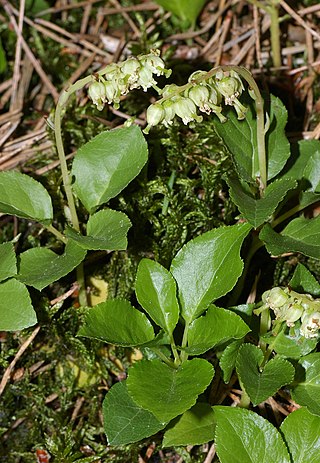
Orthilia is a genus of flowering plants in the family Ericaceae. It has only one species, Orthilia secunda. Its common names are sidebells wintergreen, one-sided-wintergreen and serrated-wintergreen. It is also called one-sided pyrola, one-sided shinleaf, and one-sided wintergreen. It was previously part of genus Pyrola, the wintergreens.
Scirpus longii is a species of flowering plant in the sedge family known by the common name Long's bulrush. It is native to eastern North America, where it is limited to the Atlantic coastal plain.

Viola brittoniana, known as coast violet, northern coastal violet and Britton's violet, is a rare, acaulescent blue-flowered violet that is endemic to the eastern United States. It has distinctive leaves with narrow lobes and deep sinuses. It is a perennial.

Viola hirsutula, common name southern woodland violet, is a perennial species of violet found in the eastern United States.
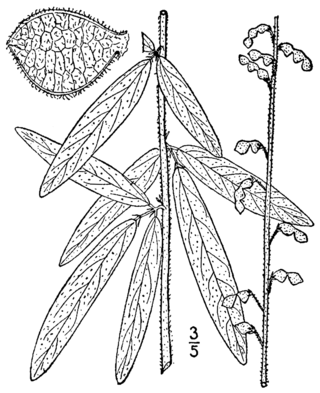
Desmodium sessilifolium, common name sessileleaf ticktrefoil, is a species of plant in the legume family, Fabaceae. It is native to North America.
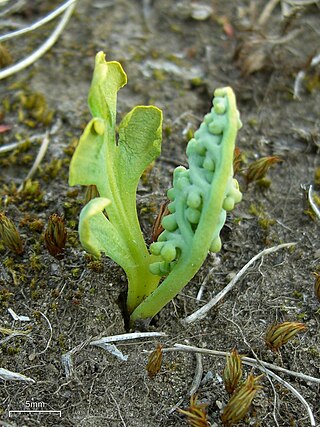
Botrychium simplex, the little grapefern, is a species of fern in the family Ophioglossaceae that is native to North America and Greenland. It is a perennial.
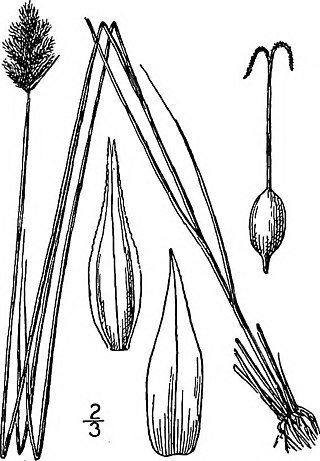
Carex crawfordii, common name Crawford sedge, is a species of Carex native to North America.

Juncus debilis, the weak rush, is a plant indigenous to the United States. It is listed as endangered in Massachusetts and New York, and as threatened in Rhode Island. It is listed as a species of special concern in Connecticut and believed extirpated in that state.
Linum intercursum, common names sandplain flax and sandplain wild flax, is a perennial plant native to the United States.
Crocanthemum dumosum, common names bushy frostweed and bushy rockrose, is a perennial plant that is native to the United States.

Gamochaeta purpurea, the purple cudweed, purple everlasting, or spoonleaf purple everlasting, is a plant native to North America.
Croton michauxii, commonly known as elliptical rushfoil, and Michaux's croton, is a plant species in the family Euphorbiaceae that is native to the United States. It is an annual plant.
Pycnanthemum torreyi, common name Torrey's mountainmint, is a perennial plant native to the United States.

Cuscuta coryli, synonym Grammica coryli, common name hazel dodder, is a perennial plant in the Cuscutaceae family native to North America.

Carex typhina, common name cattail sedge, is a species of Carex native to North America.

Lipocarpha micrantha, known as dwarf bulrush, small-flowered hemicarpha, small-flower halfchaff sedge, common hemicarpa and tiny-flowered sedge, is a species of flowering plant in the sedge family (Cyperaceae) native to North America.

Eleocharis microcarpa, common names small-fruited spikesedge, spike-rush, small-fruited spike-rush and tiny-fruited spike-sedge, is a plant in the Eleocharis genus found in North America.

Scleria verticillata, known as low nutrush or whorled nutrush, is a plant in the sedge family Cyperaceae. It is native to Ontario, Canada, the eastern United States, The Bahamas, and Cuba.
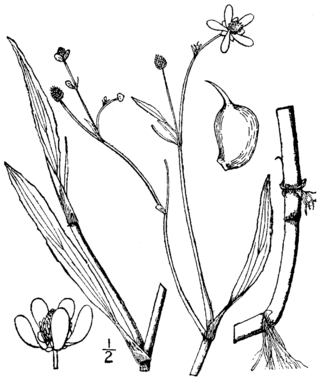
Ranunculus ambigens, common names water-plantain spearwort, water plantain, and spearwort, is a plant found in the eastern part of North America. It is listed as endangered in Connecticut, and New Hampshire; as endangered and extirpated in Maryland; as a special concern in Kentucky; as possibly extirpated in Maine; as threatened in Michigan; and as a special concern in Rhode Island.














